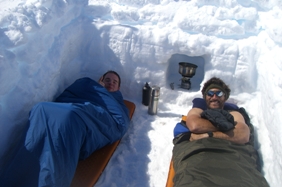
The art of pitching a tent in the Antarctic takes a while to perfect. The routine involves: digging the tent in, to improve stability should the wind pick up; levelling the site; excavating pits for cookers, and somehow managing to squeeze three fully-grown men into a tent cosy enough for one. The less said about the palatability of dehydrated rations…the better. The daily effort required to rouse oneself from the warmth of a sleeping bag to get the cooker going was considerable. In the evening, after a hard day man-hauling, we found we had to strike a balance between re-hydrating properly and avoiding the need to answer the call of nature in the middle of the night! However, the simplicity of cooking on a stationary surface was much appreciated after a swaying galley on the Southern Ocean.
The penguins we encountered were completely unfazed by humans and would gladly walk up to peck your boot laces. Humpback whales regularly came alongside the yacht, announcing their presence by jetting seawater from their blow-holes. The gentle giants would circle the boat for several minutes before diving to the depths and breaching the surface with their flukes. Orcas (killer whales) could also be seen from time to time, and seals were everywhere - often warming themselves on icebergs in the Antarctic sun.
At Paradise Harbour, towards the end of the expedition we finally succeeded in sampling the sedimentary rocks of the Trinity Peninsula Group. In addition, we collected granitoids from Mount Heogh in a vertical traverse of the mountain for thermochronological studies. We later learned that our exploits on the side of Mount Heogh generated considerable interest from the local Chilean base. Although climbing on the side of Mount Heogh was fairly exciting, the collection of the Trinity Peninsula Group sediments was arguably a much more dangerous exercise as we were infringing the territory of the local leopard seal who watched our exploits at quarters that were too close for comfort.
With our two final sampling goals complete it was time for the expedition to head north. I wondered if I would ever return, but then I realised I had thought the same though last year.
Life in the Antarctic is tough. The physicality involved in the everyday grind takes its toll; but it is mental toughness that allows one to thrive in this environment. The Antarctic is a place where you stand to lose much more than you could ever hope to gain - and perhaps that part of its allure. It is the constant danger and adversity that keeps the Antarctic explorer coming back for more. Back home, people ask me why I choose to put myself through needless hardship, and I am often left with no answer. I think it is probably a case of the old adage - ‘If you have to ask, you'll never understand’. Antarctica is a world away from the comfortable lives most of us enjoy but I found that when times were at there hardest, it was thoughts of home and loved ones that kept me positive - a sentiment shared by all my companions.
The rock samples that we collected have just been returned to the UK. They will now be curated at the University of Brighton and studied at various British and Irish institutions over the coming years.
I would like to thank the Geological Society of London and the Mineralogical Society of Great Britain and Ireland for supporting my participation in this expedition through fieldwork grants. I would also like to thank my fellow expedition members, in particular Major Richard Pattison and Colonel Richard Clements, for all their assistance with the geological fieldwork.
* Dr Conor J Ryan, formerly of School of Environment & Technology, University of Brighton, Cockcroft Building, Lewes Road, Brighton BN2 4GJ. Email: [email protected]